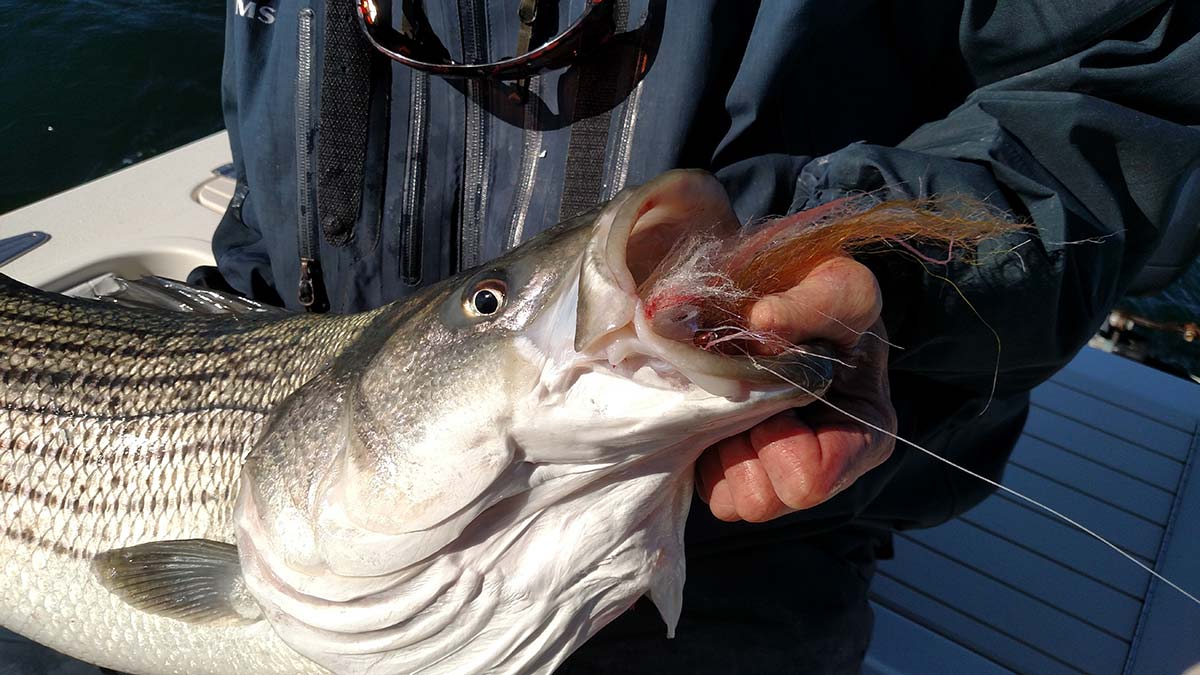Our final inshore installment of 2020 spotlights stripers on the fly.
Big striped bass on the fly, that’s enough to get a fly fisher’s adrenaline pumping and heart pounding whenever the opportunity presents itself. What stops and holds good striped bass in any particular area along the coast are tolerable water temperatures and the presence of bait. When I check my temperature logs this range for me is from 58-48 degrees.
Dropping water temperatures also coincide with the movement of sand eels and sea herring from the offshore grounds, and quickly moving pods of peanut bunker present if it is a good year run. While making the annual run down along the Striper Coast, striped bass in the 15- to 30-pound range gorge themselves on these baits creating blitz conditions where sometimes a bass can be caught on almost every cast. Where these baits set up is going to be the key to locating the bass. If the bait is found along the beach then the bass will be there too and some tremendous surf and jetty action can take place.
Sand eels are often the first bait to move inshore in the migration pattern and can be seen as dark masses on your fishfinder right on or near the bottom. You should also see the characteristic boomerangs of striped bass so don’t fish where you are not reading fish. Fly fishers should locate the bass and bait pods and drift over them using a quick sinking line. The Rio 350-450 grain InTouch Striper Sink Tip lines are good to use. These are 100-foot fly lines with a 44-foot head that sinks at 8 to 9 inches per second. The head is integrated into an intermediate running line with a cold water core that has no memory and will not tangle.

My method of fishing these sinking lines involves a little more than just casting out, letting the line sink, and then retrieving. Instead my method involves casting out and then stack mending all of the remaining fly line and about another 25 yards of backing into the water. As the boat drifts away from the line it will start to pull it tight. Once the line comes completely tight the fly will not sink anymore but rather start to come up in the water column so this is when you begin to strip.
For flies, a long slender slim profile fly will work best. Popovics’ jiggies are my number one choice to emulate the sand eel’s slender profile. Clousers and half and halfs also work well as the weighted heads of these flies will help to put these flies deeper in the water column. I fish these on 9/10 weight St Croix Legend Elite series fly rods.
When Atlantic herring are present, they’ll often travel in schools by the thousands, although they are not found congregating in surf zone. You would think that they would be since they enter our inlets and are caught there by jigging Sabiki rigs, but such is not the case. For that reason this late season shot will remain a boating event.
Finding where the major concentrations of sea herring are located outside of your home port is not difficult as striped bass will push these baits to the surface causing all kinds of surface commotion and attracting a multitude of gulls and gannets in Hitchcock style. With a good pair of binoculars or by using your radar one can spot birds working over the school from a good distance away.
To emulate sea herring you will want to cast Popovics’ Beast Fleyes, bucktail deceivers, hollow fleyes, or big half and halfs, and wide bodied deceivers. I like to use flies that are dressed with a lot of white blended in along their ventral surface with yellow, chartreuse, or hot pink on top. Cast out and use a strip-pause type of retrieve. One can catch bass on either a floating, intermediate, or sinking line since the bass will be distributed vertically in the water column.



